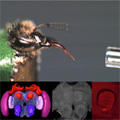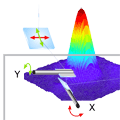Research Projects
Our research group investigates information coding, information processing and memory formation neural networks. In our work we aim at a close interaction between theoretical and experimental approaches to systems neuroscience. In a number of research projekts we concentrate on two model systems: In the mammalian neocortex we study theoretical principles of neural coding, system reliability, and motor control. In the insect brain of the honeybee we focus on the dynamics of olfactory processing, and the mechanisms underlying learning, memory formation, and decision making.
Our close collaboration with several experimental labs involves the formulation of models and testable hypotheses, experimental design, and model-based data analysis. Our theoretical approaches specialize in stochastic modeling and computational approaches to single neuron and network simulation. A stronghold of this group is our experience with the analysis of experimental data in cellular neurophysiology. Thus, part of our work is dedicated to the development and testing of methods for data analysis, in particular for uni- and multi-variate neural spiking data. Supporting the idea of transparent analyses and reproducibility of results we implement tools for empirical data analysis and make them publicly available in close collaboration with G-Node (the German INCFnode), and the FIND open source framework.
Bernstein Fokus Neuronal Basis of Learning: Insect inspired robots |
|
|
Computational neural network modules for learning, memory formation and decision-making in bioficial agents. In the collaborative research project Insect Inspired Robots: Towards an Understanding of Memory in Decision Making we combine theoretical and experimental approaches to investigate neuronal and computational mechanisms of learning, memory and decision-making in biological and artifical agents. The collaboration involves six work groups from different disciplines at the univeristies FU Berlin, Würzburg, and Freiburg. |
 |
Auditory Feature Extraction and Object Recognition |
|
|
In a few computational steps from sensory representation to feature extraction and object recognition. Within the collaborative research center Theoretical Biology: Robustness, Modularity and Evolutionary Design of Living Systems (SFB 618) we develop functional models that combine auditory processing, object recognition, and eventually the generation of choice behaviour. In this project, we closely collaborate with the experimental group of Dr. Matthias Hennig. |
 |
Graduate School Sensory Computation in Neural Systems |
|
|
A7 Cortical Information Processing under Non-stationary Network State Conditions In ths project we investigate models of cortical coding under non-stationary conditions and we will contrain these models on the basis of multiple single unit and local field potential recordings from the motor cortex of behaving monkeys. Theoretical approaches may include models at the level of mathematical point/noise processes as well as computation neurl network. This project involves a close collaboration with the experimental lab of Dr. Alexa Riehle at the CNRS in Marseille, France. |
|
|
B5 Cooperativity of Cortical Ensembles during Natural Vision In this project we investigate dynamic cortical ensemble coding during natural vision in close collaboration with the experimental group of Dr. Björn Kampa at the University of Zürich. Using data from 3D Ca-imaging from large ensembles of neurons in the visual cortex of rodents, we will identify the spatial and temporal coding properties during dynamic stimulation with movie sequences. The simultaneous monitoring of many neurons within a functional column will allow analyzing the size of local functional ensembles and inter-neuron correlations. Thy dynamic stimuli allow to extract information about the time-varying composition of the encoding ensemble and its dynamic coding properties. The PhD candidate is expected to apply sophisticated techniques of data analysis, in particular machine learning techniques. Goal of this project is to propose refined models for the dynamic representation and computation of natural sensory input in cortical ensembles. |
|
Olfactory Coding and Learning in Insects |
|
|
Olfactory Coding in the Antennal Lobe of the Honeybee In this project we study the neural encoding of odors in the antennal lobe of the honeybee. We combine data analysis of intra- and extracellular recordings from projection neurons and local interneurons with computational neural network modeling. Our particular interest is directed at the differential role of lACT and mACT type projection neurons and the role of local inhibition in odor coding. |
|
|
Neural correlates of learning and reward in the mushroom body. The mushroom body forms a higher center for computation and memory formation in insects. It integrates sensory information across different sensory modalities. We study learning-induced changes and reward value in the activity of mushroom body extrinsic neurons in the honeybee. Odor associations are tested under behavioural conditions in combination with simultaneous single unit recordings. |
 |
|
Computational Models of Learning and Memory Formation The honeybee's remarkable performance in associative odor learning tasks make it an ideal model organism for neuronal mechanisms of learning and memory formation. We integrate electro- and optophysiological data from all stages of odor processing into computational models of neuronal networks in order to reveal how memory formation and memory retrieval works in the honeybee brain. |
|
Working Principles and Computation in the Cortex |
|
|
Reliability of Synaptic Transmission and Dendritic Integration in Cortical Pyramidal Neurons The transmission of information through an individual neuron involves 3 stages: synaptic transmission, dendritic integration and spike initiation. Each single step involves potential sources of variability. We aim at uncovering these sources and quantifying their respective contributions using experimental and modeling approaches. |
|
|
Cortical Motor Control in Primates In this project we study the dynamic encoding of limb movement paramters in primary and premotor cortices. The single cell activity of motor cortical neurons provides a direct correlate of movement preparation and execution. Field potentials in the human cortex represent an indirect neural correlate of voluntary movement. We collaborate with the Brain Machine Interfacing Initiative (BMII) and METACOMP. |
|
Methods for Data Analysis |
|
|
New Tools for Spike Train Analysis The interplay between experimental and theoretical approaches is an integral concept of computational neuroscience. Novel tools of data analysis are crucial for interfacing with experimental data. We specifically work towards improved methods for (multidimensional) spike train analysis. We are member of the FIND initiative and partner of the G-Node. |
|
Innovative Experimental Technology |
|
|
Dynamic Photo Stimulation We develop new methods for experimental neural network stimulation in vitro using photo-release of caged neurotransmitters. Our techniques allow to activate spatio-temporal neuronal patterns in acute or cultured brain tissue. Applications focus on dendritic integration of spatio-temporal input patterns in cortical pyramidal neurons. |
 |
